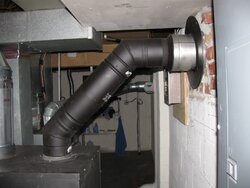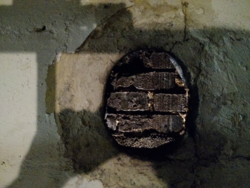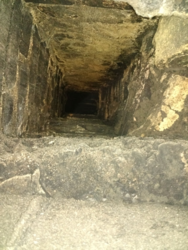We just purchased a 10-year-old Englander 28-3500. It was used about 4.5 seasons according to the seller. Aside from some broken firebrick and missing rivet pins for the ash tray door (replaced by hack-sawing a pair of 5", 3/8" dia. crown bolts from Home Depot), the stove appears to be in good condition.
I'm preparing to re-line an unused clay (terra cotta) flue by dropping a flexible stainless (316Ti) liner inside the existing liner (7-1/16" x 11-5/8", inside dimensions). The clay liner extends above the chimney crown several inches. The liner + T connector and snout will be a bit shy of 30 ft. The flue is in a dual-flue chimney on exterior wall. One is currently unused and goes to a first-floor fireplace. The flue to be re-lined goes to the basement. Below the throat (? -- bottom-most clay liner section) is brick and cinder block construction. The throat area and stove pipe hole through cinder block into this throat area are offset somewhat. There is an interior cleanout door cut into the cinder block, below the stove pipe hole. An old oil boiler (since removed) had connected to this flue. There was a simple stove pipe that connected to the boiler and went through the stove pipe hole in the cinder block. There was no thimble and the pipe didn't continue upwards into the clay liner. From discussion with a local wood stove / stainless liner retailer, insulating the stainless liner isn't necessary. I am planning to use double-wall black stovepipe between the stove and wall (thimble?), with a damper somewhere in that run. The goal is something that looks similar to this (from another Hearth forum topic):

Can I safely connect the double-wall black stove pipe "directly" to a T-connector snout extending through the stove pipe hole in the cinder block, or do I need to have some type of thimble connector? If so, I'll possibly need to enlarge the stove pipe hole in the cinder block...?
Any ideas on insulating the stainless liner vs installing without insulation?
Other suggestions?
Thank you!
I'm preparing to re-line an unused clay (terra cotta) flue by dropping a flexible stainless (316Ti) liner inside the existing liner (7-1/16" x 11-5/8", inside dimensions). The clay liner extends above the chimney crown several inches. The liner + T connector and snout will be a bit shy of 30 ft. The flue is in a dual-flue chimney on exterior wall. One is currently unused and goes to a first-floor fireplace. The flue to be re-lined goes to the basement. Below the throat (? -- bottom-most clay liner section) is brick and cinder block construction. The throat area and stove pipe hole through cinder block into this throat area are offset somewhat. There is an interior cleanout door cut into the cinder block, below the stove pipe hole. An old oil boiler (since removed) had connected to this flue. There was a simple stove pipe that connected to the boiler and went through the stove pipe hole in the cinder block. There was no thimble and the pipe didn't continue upwards into the clay liner. From discussion with a local wood stove / stainless liner retailer, insulating the stainless liner isn't necessary. I am planning to use double-wall black stovepipe between the stove and wall (thimble?), with a damper somewhere in that run. The goal is something that looks similar to this (from another Hearth forum topic):

Can I safely connect the double-wall black stove pipe "directly" to a T-connector snout extending through the stove pipe hole in the cinder block, or do I need to have some type of thimble connector? If so, I'll possibly need to enlarge the stove pipe hole in the cinder block...?
Any ideas on insulating the stainless liner vs installing without insulation?
Other suggestions?
Thank you!



